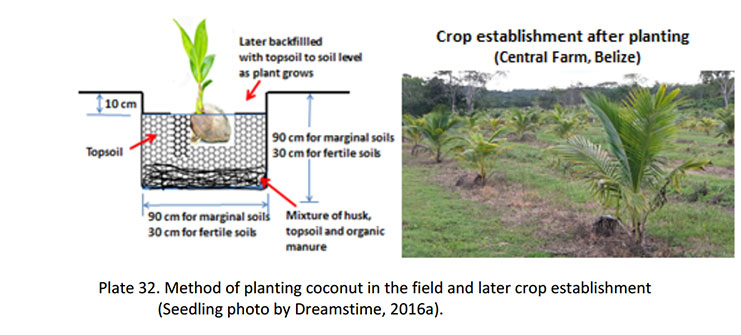The selection of the appropriate planting system for coconut seedlings is influenced by varieties, type of farming system (monocrop or intercrop), climatic and soil conditions. The Tall varieties may be planted 9m between trees (160 plants per ha), Hybrids (D x T) 8m between trees (180 plants per ha) and, Dwarfs 7m between trees (235 plants per ha).
The coconut palm grows symmetrically and maximum light availability is obtained by planting palm trees in an equilateral triangle, such that each row of trees is staggered by half the planting distance in relation to the trees in the rows on either side. Each tree is thus equidistant from the six nearest trees.
Fields should be lined according to the planting arrangements and plant spacing. In the various planting arrangements, rows should be aligned North–South to allow maximum sunlight to each plant. The task of lining up consists of using stakes 1.2 – 1.5 m long to mark the rows so as to obtain the required planting density. Some string and a measuring tape can be used in small areas; for larger areas, precision instruments such as a sighting telescope or theodolite can be used.

Planting should be done at the beginning of the rainy season. Hence, timing of the nursery should be planned in accordance with the seasonal changes. Seedlings should be 8 – 10 months of age for better growth and development. They should be planted immediately or at least 3 days after removal from the nursery to avoid mortality.
For each planting hole, an area of soil 1m in circumference is cleared of all vegetation and leveled. In fertile soils, holes should be dug 30 x 30 x 30 cm and in marginal soils, holes 90 x 90 x 90 cm are recommended. The planting holes can be dug at least one month before planting and filled with a mixture of topsoil, coconut husks, wood ash and well-decomposed manure then allowed to settle.
Seedlings are transported to the planting site by tractor and trailer or truck. The seedling is then placed in the hole and backfilled with topsoil mixed with 30g NPK (12-24-12). Handle the seedling carefully so that the sprout is not damaged. The nut is covered with soil mix which is gently pressed into place so that the central bud and the collar of the shoot are above the soil level.
The soil surrounding the seedling is raked and the seedlings are irrigated adequately. Irrigation is recommended immediately after planting. As the plant grows, soil is backfilled to the surrounding soil level.



.jpg)











